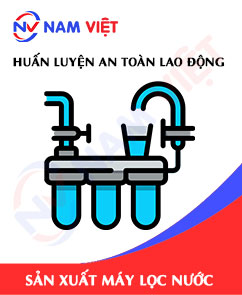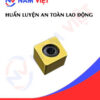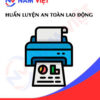Occupational Safety Training in Water Purifier Manufacturing
99,000 ₫
Note: The above price is calculated per person, and the price may fluctuate depending on the number of trainees participating in the course and the market movements. For more accurate price support, please refer to the price list or contact our consulting staff directly.
Occupational safety is an important issue in factories manufacturing water purifiers and needs to be addressed promptly to ensure the health and safety of workers and enhance the reputation of businesses. The Occupational Safety Training course is one of the effective solutions to raise awareness about preventing workplace accidents for workers participating in water purifier manufacturing.
Table of Contents
Toggle1. Overview of Water Purifiers
a. What is a Water Purifier?
A water purifier, also called a drinking water purifier, household water purifier, or purified water purifier, is a device used to filter and purify drinking water. It is designed to remove contaminants, bacteria, viruses, chemicals, microorganisms, and other impurities that may be present in water.
Water purifiers are commonly used in households, companies, schools, and government agencies to provide clean and safe drinking water. They can operate using various methods such as mechanical filtration, chemical filtration, and membrane filtration.
There are many types of water purifiers, ranging from simple models to more complex devices with multiple functions. Common types of water purifiers include filter tanks, household water purifiers, ultra-pure water purifiers, desalination purifiers, and hot & cold water purifiers.

b. Main Components of a Water Purifier
The main components that make up a complete water purifier usually include:
- Filtration system: The filtration system consists of different filters, which may include activated carbon, reverse osmosis, ultra-fine filters, and sand/gravel filters to remove impurities from water.
- Water pump: The water pump increases pressure and moves water through the filters.
- Control system: The control system includes electronic components, controllers, sensors, and other parts to regulate pressure, temperature, filtration level, and other parameters.
- Water supply system: The water supply system includes pipes, valves, tubing, and other components to deliver purified water from the tank to distribution points.
- Electrical system: The electrical system includes electronic components, electrodes, power sources, and other parts to supply electricity to the control system and other devices.
- Machine casing and other parts: The casing and other parts include plastic, metal, and additional components to complete the device.

c. Water Purifier Manufacturers in Vietnam
Famous water purifier brands on the market today include:
- Kangen Water: A well-known brand from Japan’s Enagic, producing alkaline ionized water purifiers to enhance health.
- A.O. Smith: A U.S. water purification brand producing RO (reverse osmosis) water purifiers to remove impurities, bacteria, and other harmful substances.
- Coway: A Korean brand producing household water purifiers and air purifiers, known for quality and advanced features.
- Pureit: An Indian brand producing RO and UV (ultraviolet) water purifiers, removing impurities and bacteria.
- Panasonic: A Japanese brand manufacturing water purifiers with various technologies including RO, UF (ultra-filtration), and mineral bottom filtration.
- Aquasana: A U.S. brand producing water purifiers using multiple methods, including RO, mineral filtration, and lead removal filters.
- Brita: A German brand producing household water purifiers and bottled water filters, including carbon and ion exchange filters.

d. Specific Jobs in a Water Purifier Factory
Group 1
- Executive director, deputy executive director, department heads in the water purifier manufacturing factory.
Group 2
- Safety officers: Manage safety in the factory, design safety procedures, monitor and ensure employees follow safe working practices.
Group 3
- Purchasing raw materials and components: Technicians and accountants contact suppliers to purchase materials and components needed for water purifier production.
- Component production: The factory may produce some internal components of water purifiers, such as filters and plastic parts.
- Product assembly: Assembly staff assemble components and parts to create complete water purifiers. This process is usually performed on production lines.
- Quality inspection: After assembly, the factory conducts quality checks to ensure water purifiers operate correctly and meet quality and safety standards.
- Packaging: Once quality is checked, products are packaged and stored in the warehouse for delivery.
- Maintenance and repair: The factory has maintenance and repair staff to ensure water purifiers function properly throughout customer usage.
Group 4
- Office, service, sales, marketing jobs.
- Production management, quality management, human resource management, material management, finance and accounting management.
- Product design: Engineers and design teams plan and design products to ensure water purifiers function well and meet quality and safety standards.

2. Overview of Occupational Safety Training for Water Purifier Manufacturing
In this article, we focus on Group 3 because Group 3 directly participates in production and faces the highest occupational safety risks. See other groups here.
a. What is Group 3 Occupational Safety Training?
- Group 3 occupational safety training provides workers with knowledge and awareness on preventing workplace accidents.
- The training helps workers recognize hazards and minimize risks of accidents while working.
REGISTER FOR OCCUPATIONAL SAFETY TRAINING SERVICE
b. Training Duration
Initial safety training
- Total training duration is at least 24 hours, including tests.
- 8 hours of theory on policies, labor laws, and occupational hygiene
- 8 hours of basic safety and hygiene theory
- 4 hours of specialized training theory
- 2 hours of practical exercises on specialized training
- 2 hours of theoretical test at the end of the course
The training center schedules multiple sessions depending on workers’ availability, usually 6 sessions over 3 days, provided the enterprise allows continuous learning.
Periodic safety training
- Before the occupational safety card expires, workers seeking renewal must undergo periodic occupational safety training with at least 50% of the initial training duration.
Explanation: Total periodic training time is at least 12 hours, including tests. After completing training and passing the test, the worker’s safety card is renewed.
c. Training Content
| No. | TRAINING CONTENT | TRAINING HOURS | |||
| Total | Including | ||||
| Theory | Practice | Test | |||
| I | Policies, labor laws, and occupational hygiene | 8 | 8 | 0 | 0 |
| 1 | Overview of legal documents on occupational safety and hygiene. | 6 | 6 | ||
| 2 | System of standards and technical regulations on occupational safety and hygiene. | 1 | 1 | ||
| 3 | Specific regulations from state management agencies regarding occupational safety and hygiene when constructing, expanding, or renovating facilities, and inspecting machines, equipment, materials, and substances with strict safety requirements. | 1 | 1 | ||
| II | Basic knowledge of occupational safety and hygiene | 8 | 8 | 0 | 0 |
| 1 | Basic knowledge of hazards and harmful factors at the workplace. | 4 | 4 | ||
| 2 | Methods to improve working conditions. | 1 | 1 | ||
| 3 | Safety culture in production and business. | 1 | 1 | ||
| 4 | Rights and obligations of employers and employees; safety policies; roles and responsibilities of safety networks and officers. | 1 | 1 | ||
| 5 | Safety regulations, signs, guidance, use of safety equipment and personal protective equipment; first aid and occupational disease prevention skills. | 1 | 1 | ||
| III | Specialized training content | 6 | 4 | 2 | 0 |
| Comprehensive knowledge of machines, equipment, hazardous substances; risk assessment and management; safe working procedures with machines, equipment, and hazardous substances. | 6 | 4 | 2 | ||
| IV | Final safety training test | 2 | 2 | 0 | 0 |
| Total | 24 | 22 | 2 | ||
See more training content of all 6 groups
d. Occupational Safety Card
After completing safety training and passing the test, workers are issued an occupational safety card (commonly called Group 3 safety certificate).
The Group 3 safety card clearly shows the worker’s name, date of birth, job, and specific work environment, as well as training duration, red seal, and signature confirming course completion.
According to regulations in Clause 2 of Article 24 of Decree 44/2016/ND-CP, there are two cases:
- If the employer and employee have a labor contract, the employer must sign and stamp the occupational safety card for Group 3 workers after training and passing the test.
- If the worker is freelance or seasonal, without a labor contract, the training unit must sign and stamp the safety card after the worker completes training and passes the test.

3. Recognizing hazards affecting workers during water purifier manufacturing
During the production of water purifiers, workers may be exposed to the following hazards:
- Chemical hazards: Chemicals used in water purifier manufacturing, such as cleaning agents, adhesives, dyes, colorants, hardening agents, etc., can be harmful to workers’ health.
- Noise and vibration: Machinery in water purifier manufacturing plants often generates harmful noise and vibration that can affect workers’ health.
- Collision and injury risks: During production, accidents such as collisions, injuries from heavy objects, hard or sharp materials may occur.
- Electrical shock risks: When working with electrical equipment, workers may suffer electric shock if they do not wear proper protective equipment.
- Air pollution risks: During production, smoke, toxic fumes, and harmful gases can pollute indoor air, affecting workers’ health.
- Poisoning risks: Accidental ingestion of toxic substances or inhalation of harmful fumes may occur during production.
- Occupational accidents: Accidents such as burns, cuts, and injuries may happen when using cutting tools or knives.

4. Common occupational accidents for workers during water purifier manufacturing
Common occupational accidents in water purifier manufacturing include:
- Machinery injuries: Machines in water purifier production plants can cause occupational accidents such as cuts, wounds, crushing, and punctures if not used properly or maintained regularly.
- Chemical poisoning: Chemicals such as cleaning agents, adhesives, and softening agents may cause poisoning if workers are overexposed or use them incorrectly.
- Heat and pressure: Water purifier manufacturing may involve high-temperature and high-pressure processes. If safety regulations are not followed, employees may suffer burns or pressure-related accidents.
- Electrical accidents: Some equipment in water purifier factories may require high voltage, leading to risks such as electric shock or fire/explosion.

5. Safety measures when participating in water purifier manufacturing
To ensure workers’ safety during water purifier manufacturing, the following safety measures should be applied:
- Training and instruction: Workers must be trained on safety procedures and regulations during manufacturing, maintenance, and operation of water purifiers.
- Use of personal protective equipment: Workers should wear masks, helmets, gloves, safety glasses, safety shoes, etc., to minimize injury risks during work.
- Regular machinery inspection and maintenance: Equipment and components must be periodically checked and maintained to ensure safe and reliable operation.
- Production process monitoring and management: Establish a monitoring system to manage and supervise water purifier production processes. In case of incidents or accidents, emergency response plans should be in place for quick action.
- Compliance with occupational safety regulations: Besides specific safety measures, basic labor safety rules must be followed, such as avoiding work when fatigued, not drinking alcohol during work hours, and not using broken equipment.
- Enhance occupational safety evaluation: Regularly inspect and assess the effectiveness of applied safety measures. Adjust or supplement new measures if necessary to ensure worker safety.
- Periodically conduct occupational environment monitoring in the factory, collect and analyze harmful factors for workers, and adjust to reduce hazards to prevent occupational diseases.
6. Benefits of occupational safety training for water purifier manufacturing
An Toan Nam Viet provides your business with the following benefits after completing occupational safety training courses according to Decree 44/2016/ND – CP on occupational safety and hygiene for companies and factories:
- Workers can recognize potential occupational hazards and take preventive measures to avoid accidents.
- Your business can establish risk prevention measures in production, operation, and maintenance processes.
- Reduce costs associated with potential workplace safety incidents.
- Uninterrupted production helps increase labor productivity and product quality.
- Comply with occupational safety laws, avoiding legal risks.
- Enhance reputation and professionalism, thereby elevating your business brand.
An Toan Nam Viet’s training courses are solutions to prevent external hazards from affecting individuals, helping them avoid injury or, in severe cases, death.
REGISTER FOR OCCUPATIONAL SAFETY TRAINING SERVICE
7. Customer feedback after completing water purifier manufacturing occupational safety training
An Toan Nam Viet has many years of experience accompanying businesses across Vietnam, especially in southern provinces. This responsibility is highly valued by An Toan Nam Viet, so our occupational safety training is increasingly professional. The growth of An Toan Nam Viet is driven by positive feedback and suggestions from businesses. Below are testimonials from partners we have served.
See more customer interviews after using An Toan Nam Viet’s services
8. An Toan Nam Viet’s occupational safety training capabilities
An Toan Nam Viet is a reputable and quality occupational safety training center in Vietnam. Training sessions are continuously conducted at manufacturing workshops, factories, or construction sites nationwide (all 63 provinces in Vietnam).
REGISTER FOR OCCUPATIONAL SAFETY TRAINING SERVICE
Occupational safety training license
- An Toan Nam Viet has been inspected and certified by the Department of Labor Safety under the Ministry of Labor – Invalids and Social Affairs, confirming compliance for occupational safety and hygiene training. This strengthens our occupational safety training capabilities.

Training materials and lectures
- Before being used in occupational safety training courses, materials are reviewed to ensure accuracy and effectiveness.
- Our instructors’ teaching methods are standardized according to An Toan Nam Viet standards, developed by experts in occupational safety and hygiene training to maximize knowledge transfer.
Facilities
- Controlling classroom factors enhances teaching efficiency and knowledge retention.
- Our training facilities provide spacious classrooms meeting standards in area, lighting, and training equipment.
9. Nationwide reputable occupational safety training center
At An Toan Nam Viet, occupational safety training is our top priority. We focus on equipping workers with self-protection knowledge, contributing to the country’s development.
To ensure effective training, we carefully prepare every detail, from tools, equipment, materials, sound, to lighting.
Our instructors are experts with years of experience and research in identifying hazards across industries and preventing them. Lectures are practical, engaging, and easy to understand, adhering to Decree 44/2016/ND-CP.
Employees learn preventive measures and self-protection, applying them appropriately in their work.
Our training center is proud to offer professional, reliable occupational safety training with the following advantages:
- Competitive training costs with guaranteed quality.
- Flexible training schedules aligned with company production.
- Fast and compliant certification procedures.
- Experienced instructors.
- Classroom control enhances teaching efficiency and knowledge retention.
- Lectures tailored to enterprise occupational safety needs.
- Dedicated, professional support for clients.

10. Additional reference materials for water purifier occupational safety training
- Occupational safety training material set
- Occupational safety materials for water purifier manufacturing
- Occupational safety training test set
- Occupational safety training curriculum for water purifier manufacturing
- Occupational safety multiple-choice test for water purifier manufacturing
1 review for Occupational Safety Training in Water Purifier Manufacturing
No comments yet















namchinh.haiphong341
Đơn vị an toàn lao động uy tín tại Việt Nam nhé!